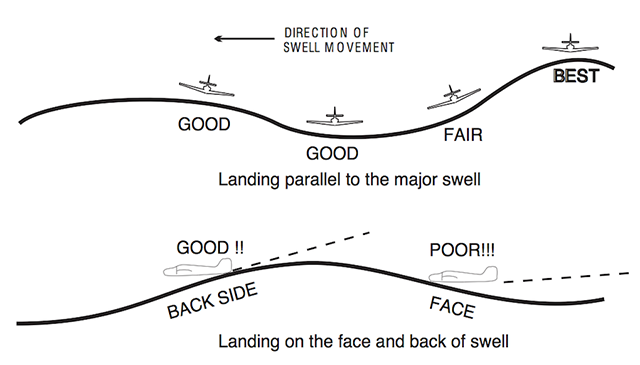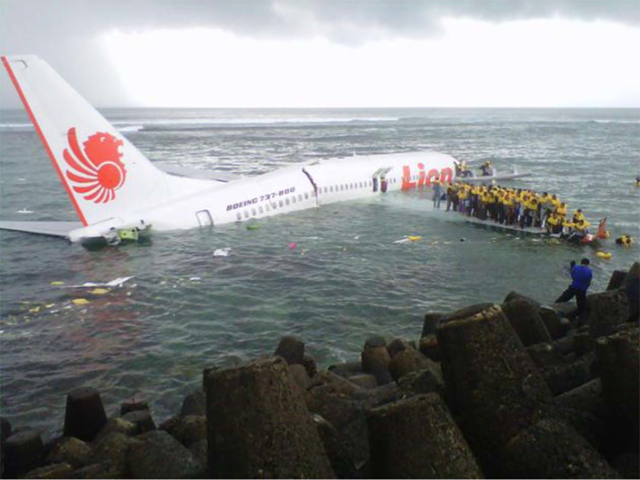I'm afraid I don't have any sage advice on the subject of ditching an airplane. The only Gulfstream to end up in the drink flew right in there on approach with no warning, landing next to a boat, and the occupants were all rescued moments later without so much as a life preserver. More about that: GIII VP-BLN. There seems to be a case like that every year or so, such as the case of Lion Air 904.
— James Albright

Updated:
2016-10-20
From the GIII incident we learned that getting the outflow (or TROV) closed prior to turning your airplane into a boat may save you from becoming a submarine. From many other incidents we see that air in the fuel tanks can help the airplane to float. Even if your tanks are full of fuel, which is less dense than water, you should be able to float for a while so long as the airplane remains intact without any holes allowing water inside.
What follows are just notes from various classes, including two flight attendant courses I was sent to evaluate. In the Gulfstream world the Quick Reference Handbook is a pretty good resource, so if you have time to prepare, start there. You should, of course, think about this as part of your regular study patterns

1
Communications
- A pilot who encounters a distress or urgency condition can obtain assistance simply by contacting the air traffic facility or other agency in whose area of responsibility the aircraft is operating, stating the nature of the difficulty, pilot's intentions and assistance desired. Distress and urgency communications procedures are prescribed by the International Civil Aviation Organization (ICAO), however, and have decided advantages over the informal procedure described above.
- Distress and urgency communications procedures discussed in the following paragraphs relate to the use of air ground voice communications.
- The initial communication, and if considered necessary, any subsequent transmissions by an aircraft in distress should begin with the signal MAYDAY, preferably repeated three times. The signal PAN−PAN should be used in the same manner for an urgency condition.
- Distress communications have absolute priority over all other communications, and the word MAYDAY commands radio silence on the frequency in use. Urgency communications have priority over all other communications except distress, and the word PAN−PAN warns other stations not to interfere with urgency transmissions.
- Normally, the station addressed will be the air traffic facility or other agency providing air traffic services, on the frequency in use at the time. If the pilot is not communicating and receiving services, the station to be called will normally be the air traffic facility or other agency in whose area of responsibility the aircraft is operating, on the appropriate assigned frequency. If the station addressed does not respond, or if time or the situation dictates, the distress or urgency message may be broadcast, or a collect call may be used, addressing "Any Station (Tower)(Radio)(Radar)."
- The station addressed should immediately acknowledge a distress or urgency message, provide assistance, coordinate and direct the activities of assisting facilities, and alert the appropriate search and rescue coordinator if warranted. Responsibility will be transferred to another station only if better handling will result.
- All other stations, aircraft and ground, will continue to listen until it is evident that assistance is being provided. If any station becomes aware that the station being called either has not received a distress or urgency message, or cannot communicate with the aircraft in difficulty, it will attempt to contact the aircraft and provide assistance.
- Although the frequency in use or other frequencies assigned by ATC are preferable, the following emergency frequencies can be used for distress or urgency communications, if necessary or desirable:
- 121.5 MHz and 243.0 MHz. Both have a range generally limited to line of sight. 121.5 MHz is guarded by direction finding stations and some military and civil aircraft. 243.0 MHz is guarded by military aircraft. Both 121.5 MHz and 243.0 MHz are guarded by military towers, most civil towers, FSSs, and radar facilities. Normally ARTCC emergency frequency capability does not extend to radar coverage limits. If an ARTCC does not respond when called on 121.5 MHz or 243.0 MHz, call the nearest tower or FSS.
- 2182 kHz. The range is generally less than 300 miles for the average aircraft installation. It can be used to request assistance from stations in the maritime service. 2182 kHz is guarded by major radio stations serving Coast Guard Rescue Coordination Centers, and Coast Guard units along the sea coasts of the U.S. and shores of the Great Lakes. The call "Coast Guard" will alert all Coast Guard Radio Stations within range. 2182 kHz is also guarded by most commercial coast stations and some ships and boats.
Source: AIM, ¶6-3-1
Remember also that your best shot a communicating your distress may be on:
- CPDLC
- ELTs
- Pilot interplane, 123.45 MHz
- Satellite Communications
See CPDLC
See ELTs
See SATVOICE/SATCOM
2
Cockpit preparation
Pilots should refer to aircraft manufacturer guidance. A few things to consider:
- Don life vests early, while you have a chance.
- Preposition things you would like to have, such as cell phones (which might work, depending on your location).
- Stow any loose items that could become projectiles during the touchdown.
- Unless your manufacturer prohibits such precautions, it might be a good idea to close any outflow valves which will be below the water line. (Your aircraft may actually float for a while if the fuel tanks have more air than fuel.)
- Setting off the ELT manually while airborne might increase your odds of being spotted earlier.
3
Cabin preparation
- Identify Able Bodied Persons (ABPs)
- Brief ABPs on use of life rafts
- Take them to the rafts
- Show them how to remove them, secure them near the exit, and how to inflate
- Stress that the raft must be secured before the exit is opened
- Brief ABPs on overwing exits
Secure Cabin
- Seat backs upright, seats tracked to their approved positions, stow tables.
- Remove dangerous objects from passengers (stow eyeglasses in a sock or seat pocket).
- Stow all loose articles, anything that could become a projectile (laptops, service dishes, flowers, etc.)
- Duct tape all galley sliding doors.
- Dim lights just prior to landing.
4
If time permits
- Distribute motion sickness medication.
- Gather MedAire and First Aid kits and seal in garbage bag, attach to inflated life vest.
- Place blankets, linens, extra clothing in sealed garbage bags.
- Put together a kit of extra water and food.
- Place any cell phones, handheld VHF radios in plastic bags.
- Locate extra flashlights and tool kits.
5
Ditching procedures
- A successful aircraft ditching is dependent on three primary factors. In order of importance they are:
- Sea conditions and wind.
- Type of aircraft.
- Skill and technique of pilot.
- Common oceanographic terminology.
- Sea. The condition of the surface that is the result of both waves and swells.
- Wave (or Chop). The condition of the surface caused by the local winds.
- Swell. The condition of the surface which has been caused by a distance disturbance.
- Swell Face. The side of the swell toward the observer. The backside is the side away from the observer. These definitions apply regardless of the direction of swell movement.
- Primary Swell. The swell system having the greatest height from trough to crest.
- Secondary Swells. Those swell systems of less height than the primary swell.
- Fetch. The distance the waves have been driven by a wind blowing in a constant direction, without obstruction.
- Swell Period. The time interval between the passage of two successive crests at the same spot in the water, measured in seconds.
- Swell Velocity. The speed and direction of the swell with relation to a fixed reference point, measured in knots. There is little movement of water in the horizontal direction. Swells move primarily in a vertical motion, similar to the motion observed when shaking out a carpet.
- Swell Direction. The direction from which a swell is moving. This direction is not necessarily the result of the wind present at the scene. The swell may be moving into or across the local wind. Swells, once set in motion, tend to maintain their original direction for as long as they continue in deep water, regardless of changes in wind direction.
- Swell Height. The height between crest and trough, measured in feet. The vast majority of ocean swells are lower than 12 to 15 feet, and swells over 25 feet are not common at any spot on the oceans. Successive swells may differ considerably in height.
Source: AIM, ¶6-3-3
Flying a jet with a small cockpit window, high approach speed, and what might be a fairly high sink rate are you really going to be able to evaluate the primary and secondary swells? The Aeronautical Information manual goes on to caution: AVOID THE FACE OF THE SWELL. That is fine advice too, but if you are timing your approach to land on the back side of a swell, the cost of failure is quite high. Looking at the following diagram makes it clear to me that landing parallel to the swell is the way to go.

Wind-swell ditching heading, from AIM, figure 6-3-5.
6
Flight attendant notes
- Receive situation briefing from PIC.
- Brief passengers, get them started on personal preparation (below).
- Prepare the cabin.
- Once aircraft has stopped assess the conditions and say: "Stay seated, stay seated, I am opening an exit."
- Secure the life raft's mooring line to a seat belt (mooring lines have a built-in fail of about 500 lbs, they will not drag the life raft under).
- To command the evacuation:
- "Open your seat belts"
- "Come this way"
- "Come to my voice / flashlight"
- "Leave everything"
- "Inflate your vest on the wing"
- "Follow the line to the raft"
- Pick an exit.
- At a window exit:
- "Step up, step through"
- "Leg, body, leg"
- "Run away from the aircraft"
- During an evacuation passengers may become incapacitated. Evacuate the able bodied first, seek their assistance to help those who need it.
- Tell the first person to exit to assist other passengers and send them away from the aircraft.
- Count those evacuating to ensure all are accounted for.
- Bring the medical kit, blankets, coats, if time permits.
7
After evacuation
- Get off the aircraft and into the rafts as soon as possible.
- Rinse off any jet fuel.
- Keep the raft attached to the aircraft as long as possible but be alert to cut the mooring line if necessary.
- Tie the rafts together.
- Assess any injuries and begin working on rescue.
- Reduce any unnecessary activity.
References
(Source material)
Aeronautical Information Manual
Montgomery, Dave, "Blue Water Ditching," Business & Commercial Aviation, October 2014.
